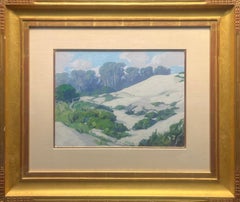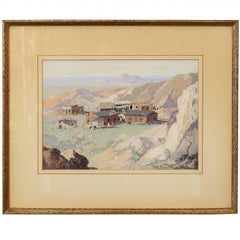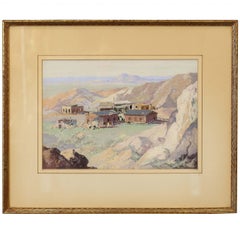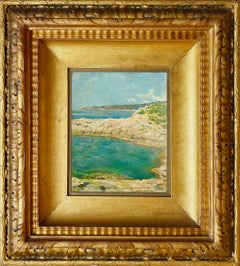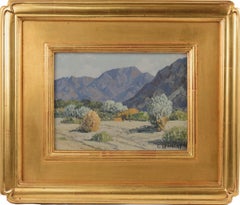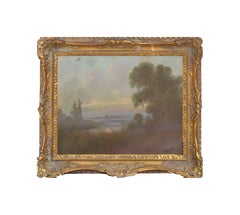Carl Sammons Art
to
1
3
3
3
2
Dunes on California Coast, c 1930s
By Carl Sammons
Located in Pasadena, CA
Consigned to the gallery, Pasadena, California; By descent to a private collector, Encino, California; Acquired in 1998 by a private collector, San Carlos, Palo Alto, and Oceanside, California; From the Santa Barbara Historical Society
Signed "Carl Sammons" on lower right
Description
This luminous coastal landscape by Carl Sammons is a striking example of the artist’s signature plein air style, depicting the rolling coastal dunes and lush vegetation of California’s shoreline. Best known for his depictions of Carmel and Monterey, the composition and palette of this work suggest inspiration from the Monterey Peninsula dunes. Sammons’ ability to merge vibrant, clean color with a sense of atmospheric perspective is evident here in the interplay of bright, sunlit sands and the rich greens of windswept foliage. His vibrant yet naturalistic color harmonies, crisp edges, and keen sensitivity to light bring the fleeting beauty of the coastal environment to life. The hazy eucalyptus grove in the background adds a distinctive regional touch, situating the composition firmly within California’s coastal identity. Sammons’ paintings of California’s unique landscapes played a significant role in documenting the natural beauty of the state during the early 20th century.
Connection to the Monterey Art Colony
By the 1920s and 1930s, Sammons became closely associated with the Monterey art colony, an influential hub for plein air painters such as Armin Hansen (1886–1957), William Ritschel (1864–1949), and Percy Gray...
Category
1930s Impressionist Carl Sammons Art
Materials
Oil, Board, ABS
California landscape
By Carl Sammons
Located in Houston, TX
Considered one of the early "California Impressionists" Carl Sammons is known for plain air landscapes that featured the flowering plants native to the coasts, mountains, and desert...
Category
1930s Impressionist Carl Sammons Art
Materials
Pastel
$1,920 Sale Price
20% Off
Carl Sammons '1883-1968'
By Carl Sammons
Located in Houston, TX
Considered one of the early "California Impressionists," Carl Sammons is known for plein air landscapes that featured the flowering plants native to the coasts, mountains, ...
Category
Mid-20th Century American Art Deco Carl Sammons Art
$2,400
Related Items
The Opal Pool - Coast of Catalina, Spain
By Francis Luis Mora
Located in New York, NY
A very rare and exceptional work by one of America's most versatile and interesting American Impressionists. This was done on an early trip the artist made to Spain.
The artist live...
Category
Early 1900s Impressionist Carl Sammons Art
Materials
Oil, Board
Mallorca oil on cardboard painting impressionism spanish seascape
By Joaquin Terruella Matilla
Located in Sitges, Barcelona
Joaquin Terruella Matilla (1891-1957) - Landscape - Oil cardboard
Oil measures 10x14 cm.
Frame measures 20x25 cm.
Joaquim Terruella Matilla (1891 - 1957)
Joaquim Terruella Matilla,...
Category
1920s Impressionist Carl Sammons Art
Materials
Cardboard, Oil
$432 Sale Price
55% Off
H 3.94 in W 5.52 in
Olive trees Soller Mallorca Spain oil on board painting spanish landscape
Located in Sitges, Barcelona
Title: Olive Trees, Sóller, Mallorca
Artist: José Ventosa Domènech (1897-1982)
Technique: Oil on panel
Unframed dimensions: 15 x 18 in
Framed dimensions: 23.6 x 26.7 in
Signature: Si...
Category
1950s Impressionist Carl Sammons Art
Materials
Oil, Board
$1,080 Sale Price
50% Off
H 14.97 in W 18.12 in
“Village Street” by Mary Nicholena MacCord, American Impressionist European Town
By Mary Nicholena MacCord
Located in Yardley, PA
A wonderful view of a charming European town. This work captures the quiet intimacy of a cobbled lane, its golden stones leading the viewer toward a cluster of whitewashed and brick ...
Category
Early 20th Century American Impressionist Carl Sammons Art
Materials
Canvas, Oil, Board
$2,750
H 26.75 in W 22.75 in D 1.25 in
Barcelona view urbanscape oil painting Spain spanish
By Josep Marfa Guarro
Located in Sitges, Barcelona
Josep Marfa Guarro (1928-2014) Barcelona Spain Oil
Oil on canvas glued to cardboard.
Oil measures 23x28 cm. Frameless.
Josep Marfa Guarro (1928-2014)
Josep Marfa Guarro was a Cata...
Category
1990s Impressionist Carl Sammons Art
Materials
Canvas, Oil, Cardboard
$264 Sale Price
56% Off
H 9.06 in W 11.03 in
“Bermuda Coast” Henrietta Dunn Mears American Impressionist Oil on Board Signed
By Henrietta Dunn Mears
Located in Yardley, PA
A vibrant Bermuda seascape depicting the rocky shoreline with turquoise waters breaking against sunlit boulders beneath a sweeping tree. Mears uses bold, textured brushstrokes and a ...
Category
20th Century American Impressionist Carl Sammons Art
Materials
Oil, Board
$1,950
H 19.5 in W 23.5 in D 1 in
American 20th century landscape painting of Eccleston Abbey UK by Horton, pastel
By William Samuel Horton
Located in Petworth, West Sussex
William Samuel Horton (American, 1865–1936)
Eccleston Abbey
Pastel on paper
Signed lower left ‘W. S. Horton’, further signed ‘Horton’ on an old label to the reverse
18 × 23¾ in. (45....
Category
20th Century Impressionist Carl Sammons Art
Materials
Paper, Pastel
$2,751
H 18 in W 23.75 in D 1 in
Colorful Lake Reflections, Large-Scale Pastel Landscape with Ducks
Located in Soquel, CA
Vibrant large-scale pastel landscape of colorful reflections rippling on a calm lake with three small ducks and a boat by an unknown artist (American, 20th Century). Signed with the ...
Category
Late 20th Century American Impressionist Carl Sammons Art
Materials
Paper, Pastel
Siebe Johannes Ten Cate (1858-1908) A Dune Landscape, pastel signed
By Siebe Johannes Ten Cate
Located in Paris, FR
Siebe Johannes ten Cate (1858-1908)
A Dune Landscape
Signed lower right
Pastel on paper
25.5 x 39.5 cm
in good condition, very fresh, traces of pinholes in the upper corners barely...
Category
1890s Impressionist Carl Sammons Art
Materials
Pastel
$2,221
H 10.04 in W 15.56 in
Playa con Llüats, Beach and Boats
By Francis Luis Mora
Located in New York, NY
A very dear and special work by Francis Luis Mora done while he was in Spain. An important trip early in his career, this is a gem of American Impressionism in technique and history...
Category
Early 1900s Impressionist Carl Sammons Art
Materials
Oil, Board
Home Safe
By James Gale Tyler
Located in Greenville, DE
Very well executed seascape. Alternate title "In Point" inscribed on the rear. 17 x 15in in frame, including linen liner. ...
Category
Late 19th Century Impressionist Carl Sammons Art
Materials
Oil, Board
Antique American Impressionist Pastel Landscape Painting Alameda California
By Edwin C. Siegfried
Located in Portland, OR
Antique California Impressionist landscape pastel painting on paper, by Edwin C. Siegfried (1889-1955), most likely a scene in Alameda circa 1930.
A beautiful Impressionistic paintin...
Category
1920s American Impressionist Carl Sammons Art
Materials
Paper, Pastel
$2,250
H 30 in W 26 in D 2 in
Previously Available Items
Mid Century Smoke Trees, Palm Springs Landscape
By Carl Sammons
Located in Soquel, CA
Gorgeous mid-century Palm Springs landscape with Smoke Trees by Carl Sammons (American, 1883-1968), circa 1950. Signed lower right corner. Titled on verso. ...
Category
1950s American Impressionist Carl Sammons Art
Materials
Canvas, Oil, Cardboard
Mountains and Sea, 1920
By Carl Sammons
Located in Soquel, CA
Sunbstantial and rare pastel impressionist landscape by Carl Sammons (American, 1883-1968). Presented in a giltwood frame. Signed "Sammons" lower right. Image size, 11"H x 13"W.
Carl Sammons was one of the noted early California Impressionists. He was a long-time resident of the San Francisco Bay Area and a prolific Plein Air artist. Sammons is known best for his California representational landscapes and coastal scenes. While much of his work was done in California, he traveled and painted throughout the West. In his early career, Sammons painted Tonalist pastels and some sources list him as a Pastelist. However, around 1920 Sammons added vivid color and Impressionistic brush strokes to his repertoire. At the same time he began painting oils and these comprise the majority of his work. The renowned early California Impressionist John M. Gamble praised Sammons' work on several occasions and was reported to have said that Sammons was the best painter of flowers in the west. More recently, Alfred C. Harrison, Jr. of The North Point Gallery, San Francisco said that Sammons was the best pastel landscape painter America has produced.
Carl Sammons was born in Kearney, Nebraska to John B. Sammons and Elizabeth (a.k.a. Lizzie) Danford Sammons on May 9, 1883. Many sources list Sammons' birth date as May 9, 1886. However, at the time of the 1885 Nebraska State Census, two year old Carl and his family were living in the Riverdale Township, Buffalo County, Nebraska. The 1900, 1910 and 1920 United States Federal Census further confirm Sammons' birth date as 1883. He was the seventh of eight children. Sammons' mother and father were both born in Ohio. His father was a farmer but served in the Union Army during the Civil War.
Sammons grew up in Kearney, Nebraska and began working as a sign painter there. In 1905 Sammons moved to Sioux City, Iowa and began working for Ashley & Loft, a sign painting company where he painted signage up to and including billboards. Although he worked in Sioux City, he kept his legal residence in Kearney (as evidenced by his name being listed in the 1910 Kearney Federal Census and the 1910-1911 Kearney City Directory). Sammons went on to work for the Sioux City sign painting companies Arthur Loft in 1909 and 1910 and C W Ashley in 1911 and 1913.
Later in 1913, Sammons moved to Petaluma, California where his sister, Mary E. Dye, lived. By the spring of 1916, Sammons had moved to Monte Rio, California where he opened an art studio. Sammons lived in Oakland, California in 1917 and moved back to Kearney later that same year. Based on the Federal Census, Sammons' father passed away between 1910 and 1920. It's possible that his father's passing was the reason Sammons returned to Nebraska when he did. In early 1920 Sammons joined the local chapter of the Elk's Lodge in Kearney. Even though he had put down roots in Kearney, Sammons hadn't forgotten California and he returned to the state in 1920 when his mother moved to Long Beach, California. From then on, Sammons earned his living solely as an artist and called California his home. At least five of his siblings (the five youngest) eventually moved to California.
On February 3, 1923, Sammons married Queen Esther Stewart. Queen, a native Californian, was born on May 14, 1893 to Calvin Stewart and Frances Julia Cooper Stewart residents of Fort Bragg. Queen was the youngest of seven children. At the time of their marriage, Queen was living in Petrolia (one of Sammons' favorite locations to paint). Sammons and Queen had much in common: a love and appreciation of California; a religious belief in God; and both came from large families whose parents were born in the Midwest. This was the first and only marriage for both of them. They were married in the Oakland home of a friend, F. E. Lucas, by the minister of the First Lutheran Church, Oakland. They settled in Oakland and traveled widely throughout the West. During their first years of marriage Queen went by Bess or Bessie.
Sammons was a quiet, soft spoken and gentle man who was heavily influenced by his Midwest upbringing. Nevertheless, in some ways he was a contradiction. He was a very private man; yet he was also a warm and friendly person who waved to passers-by while outdoors painting and sketching. He eschewed the limelight but enjoyed the children who would occasionally watch him paint, sometimes sending them on errands to fetch something for him, e.g., a piece of redwood bark so he could get the color right in his paintings.
Sammons was a careful and deliberate person. His niece recalls that when he came to visit "there was a place for all of his paint equipment in his car and it would always go back exactly in the designated location along with luggage, picnic basket, etc." He was also a proud and honest man. A friend asked Sammons to do some restoration work on a painting of birds. Sammons didn't normally do restoration work but since a friend had asked he agreed. He finished the restoration and Queen liked the painting so much that she asked him if he would copy it for her. Sammons asked his friend for permission to copy the painting and she gave it. Sammons painted a copy; however, he never signed the work since he didn't feel it was his creation. As a final point about his character, Sammons was a very humble man even as friends, fellow artists and art critics praised his work. After a career that spanned more than fifty years, Carl Sammons died in Oakland on February 4, 1968. Services were held on February 6, 1968 at the Telegraph Avenue Chapel of the Grant Miller Mortuaries, Oakland. Sammons was survived by his wife (she lived to be 103 and passed away March 19, 1997 in Moraga, California); a sister, Mrs. Mary E. Dye, Petaluma; his brother, Roscoe C. Sammons, Long Beach; nieces and nephews. Both Carl and Queen were cremated and their remains interred at the Chapel of the Chimes, Oakland.
Painting was a lifelong passion for Sammons that began in his childhood. Like several other early California Impressionists, Sammons "was inspired to paint landscapes by his belief in God and his love of God's creation." Sammons began his formal art studies in Sioux City while working as a gold letter sign painter. During this time he studied under the leading local artist F. P. Frisch, a German painter. Around 1920, Sammons studied at the California School of Fine Arts (at the time affiliated with the University of California and now known as the San Francisco Art Institute). It seems likely that this is where Sammons studied oil painting. One newspaper article implies that Sammons may have studied with private instructors in New York and Germany. However, no other information has been found to validate this.
By his twenties, Sammons had developed a love of travel; something he would do for the rest of his life. In 1909 he joined two other "artistic sign writers", Seal Van Sickle and Henry Schneider, touring South Dakota. Fittingly, Sammons was an early automobile enthusiast and, by the mid-1920s, used cars extensively in his work to make painting sojourns. Many of these painting trips involved Sammons and his wife camping out by the side of their car in scenic locations far away from any accommodations. These painting trips took them throughout the West and to many national parks including Bryce, Crater Lake, Glacier, Grand Canyon, Yellowstone, Yosemite and Zion. Sammons and his wife also made numerous painting trips within California to Humboldt County, the Monterey Peninsula, Palm Springs, the Russian River, Santa Barbara and the Sierra Nevada mountains. Sammons didn't always drive to his painting locales. In 1924 he packed into the Piute Pass region of the high Sierras to paint that remote area.
During the late 1920s, Sammons was a well known and sought after artist. However, as with most artists, the Great Depression during the following decade was a very difficult time. Art was a luxury item and, as with his fellow artists, Sammons' sales were hard hit by the economic troubles. In addition, as popular art styles changed to more abstract and modern techniques, Sammons chose to continue painting in the Impressionistic style. He was able to do this and make a living at it because he was a prolific painter, he sold his paintings at reasonable prices and he was a talented artist. It was during this time that John M. Gamble, the renowned early California Impressionist, praised Sammons as the best painter of flowers in the west.
Sammons painted a wide range of natural scenes. "His many works included landscapes, seascapes, high mountains, lakes, coastal ranges, the desert and its flora, rolling California hills, thundering breakers, scenes in all seasons, an occasional bouquet of flowers and even birds." Within California, Sammons' paintings include scenes from Antelope Valley, Big Sur, Cayucos, Contra Costa County (Mount Diablo and the Orinda hills), Death Valley, Humboldt County (Cape Mendocino, Davis Creek, the Eel River, the Etter Ranch, Ferndale, the Mattole River watershed, Petrolia and Shelter Cove), Laguna Beach, Mission San Miguel, the Monterey Peninsula (17 Mile Drive, the Carmel coast, the Lone Cypress, Monterey, Pacific Grove and Point Lobos), Mount Shasta, Palm Springs (Andreas Canyon, the Anza Borrego Desert, La Quinta Canyon, Mount San Gorgonio, the Palm Springs Desert and Mount San Jacinto), the Russian River (redwoods and the Russian River), the Sacramento River, the Salinas Valley (Camp Hunter Liggett and the San Miguel Mission), Santa Barbara (the Andre Clark Bird Refuge, Our Lady of Mount Carmel Church in Montecito, the Santa Barbara coast and the Santa Barbara Mission), San Diego (the Laguna Mountains), San Francisco (the Cliff House, Golden Gate Park and Sausalito), the Sierra Nevada mountains (Blue Lake, Convict Lake, Garnet Lake, Gull Lake, June Lake, King's Canyon, Lake Diaz in Lone Pine, Lake Ellery, Lake George, Lake Mary, Lake Sabrina, Lake Tahoe, the Mammoth Lakes region, the Merced River, the Minarets, Mount Ritter, Relief Peak, Rush Creek, Silver Lake, the Sonora Pass, Tee Jay Lake, Twin Lakes, Virginia Lake and Yosemite) and Warner Hot Springs.
Sammons also painted throughout the West including Arizona (the Apache Trail, the Grand Canyon, the Oatman Mines, the Painted Desert, the Superstition Mountains, the Tucson desert, the Tucson Mission and the Virgin River Canyon), Colorado, Montana (Glacier National Park), Nevada, New Mexico, Oregon (Crater Lake and Diamond Lake), Texas, Utah (Bryce Canyon and Zion Canyon), Washington and Wyoming (the Grand Tetons, Jackson Hole, Jackson Lake, the Madison River, Mount Moran and Yellowstone). He painted in Nebraska (the Elkhorn River) and outside the continental United States in Alaska (Mount McKinley) and Canada (the Bow River and Lake Louise in Alberta). Sammons had studios in a number of locations throughout California during his career. In addition to the studio in Monte Rio on the Russian River, Sammons maintained a studio in San Francisco during the mid-1920s. When he and Queen lived in Oakland, he also kept a studio there. Beginning in the 1930s and continuing into the mid-1950s, Sammons and his wife followed a yearly routine of traveling around California. They stayed in areas they liked for months at a time and went on painting excursions from these temporary homes.At these locales, Sammons would set up a studio. Other times, Sammons would make pencil sketches as he traveled to be used as a guide for painting in his studio.
When it came to art club membership, it seems that Sammons was a pragmatist, participating in organizations that gave him an active venue to exhibit and sell his paintings. In the 1920s, Sammons was a member of the Alameda County Art League, the Berkeley Fine Arts League and the Art League of Santa Barbara. In 1940 Sammons was a member of the American Artist's Professional League (AAPL). He received an award from the League for "distinguished participation" in November 1940 for his involvement in the American Art Week exhibition held in Oakland. In 1941 Sammons was nominated for membership in the Society for Sanity in Art (later to be renamed the Society of Western Artists); however it is not known if he ever joined that organization. In 1942 he was a member of the Rocky Mountain Artists Association. Sammons was made an honorary member of the Redwood Palette Club, most likely in the early 1950s. Sammons may have been associated with the Desert Art Center, Palm Springs in the early 1950s as his presence in Palm Springs is mentioned in two Desert Art Center newspaper articles. However, the Desert Art Center's remaining records from that period contain no reference to him.
As many artists did, Sammons willingly shared his knowledge of art with others. William E. Frates (1896-1969) studied under Sammons, as did Henry Vardon Going (1913-1954). Sammons was also known to give art advice when asked. For a short time, around 1960, he taught art students at his home in Oakland. However, Sammons soon found that many of these students asked for too much help and their paintings began to look exactly like his work. He didn't feel that these students were expressing their own individual styles and he ceased formally teaching art.
The 1923 California Industries Exposition in San Francisco marks the beginning of Sammons' public recognition as an early California Impressionist. In 1925 his work was exhibited at the Berkeley League of Fine Arts' Third Annual Exhibition, Berkeley; in 1926 at the California Industries Exposition, San Diego; in 1926 at the Claremont Hotel Art Gallery, Berkeley; in 1928, 1929 and 1930 at the Art League of Santa Barbara, Santa Barbara (solo); in 1928, 1929, 1930 and 1931 at La Casa de Manana Gallery, Berkeley (solo); in 1931 at the Haggin Memorial Galleries, Stockton (now known as the Haggin Museum), (solo); in 1931 at the Tahoe Tavern, Tahoe City; in 1931 and 1933 at the Courvoisier Gallery, San Francisco; in 1939, 1940, 1941 and 1942 at the Desert Inn Gallery, Palm Springs; in 1940 at the Golden Gate International Exposition, San Francisco; in 1940 at the AAPLs American Art Week exhibition, Oakland; in 1942 and 1951 at the Abilene Museum of Fine Arts, Abilene, TX (now known as The Grace Museum); in 1946 and 1948 at the AAPLs American Art Week exhibition, Hayward; in 1947 with the Artists of Cathedral City, Cathedral City; circa 1947 at the William Keith Gallery, Saint Mary's College, Moraga; in 1957 at the Alameda County Agricultural Fair, Pleasanton and in 1957 at the Crocker Art Gallery, Sacramento (now known as the Crocker Art Museum). Sammons' painting "Sacramento River Landscape" was exhibited at the Smithsonian Institution in Washington, D.C. for the United States 1976 Bicentennial celebration. The Ronald E. Walker Collection contained Sammons' works "Point Lobos", "Lupines on the Anza Borrego Desert" and "Yuccas, Palm Springs Desert". The Walker Collection was exhibited at the Nevada Museum of Art, Reno in 1993, the Grace Hudson Museum, Ukiah in 1997, the Hearst Art Gallery, Saint Mary's College, Moraga in 1997 and the Carnegie Art Museum, Oxnard in 1998. Sammons' painting "Point Lobos" was displayed on the front cover of the book published in connection with the Nevada Museum of Art's exhibit of the Walker Collection.
At the 1923 California Industries Exposition, Sammons' work first came to the attention of Harry Noyes Pratt. Pratt was well known in the art world and was, at various times, editor of the Overland Monthly, art critic for the Sunday San Francisco Chronicle, Director of the Haggin Memorial Galleries and Director of the Crocker Art Gallery. Pratt praised Sammons' work on a number of occasions and the two became life long friends. Other critics appreciated Sammons' work too. In the 1920s, Sammons was described as "one of California's outstanding artists" and as a "famous western painter." Sammons' work was complimented by Florence Wieden Lehre, art critic for the Oakland Tribune, Assistant Director of the Oakland Art Gallery (now known as the Oakland Museum) and later Pacific Coast editor for the Art Digest. As previously mentioned, Sammons' fellow artist John Gamble held his work in high esteem. During his life, Sammons' paintings were sold to people with homes around the world; however, today he isn't as well known as many other early California Impressionists.
Sammons didn't participate in many public exhibits during his long career. However, when he did participate in public exhibitions it was alongside well renowned California artists. During his career some of the artists he exhibited alongside included Carl Oscar Borg (1879-1947), Jessie Arms Botke (1883-1971), Maurice Braun (1877-1941), William Clapp (1879-1954), Maynard Dixon (1875-1946), John Gamble (1863-1957), Arthur Gilbert (1894-1970), Selden Gile (1877-1947), Percy Gray (1869-1952), Armin Hansen (1886-1957), John Hilton (1904-1883), Maurice Logan (1886-1977), Jean Mannheim (1863-1945), Edgar Payne (1883-1947), Hanson Puthuff (1875-1972), Granville Redmond (1871-1935), William S. Rice (1873-1963), William Ritschel (1864-1949), Milliard Sheets (1907-1989), Jack Wilkinson Smith (1873-1949), James Swinnerton (1875-1974), William Wendt (1865-1946) and Theodore Wores (1859-1939).
Although Sammons' early works are painted in the Tonalist style, the majority of his work is a combination of Impressionism, Post-Impressionism and the American Realist tradition that fits squarely into the California Eucalyptus School of painting. Just as it is important to describe the style Sammons used, it is equally important to describe what his method does not include. Sammons' was not a Modernist. His paintings are not Symbolic, Abstract or Expressionist; nevertheless, they do embody a spirituality of the land.
Sammons' early pastels contain many Tonalist elements. These early paintings portray nature as idyllic and serene. Sammons used narrow, yet harmonious ranges of color along with diffuse lighting to evoke these peaceful and quiet moods. Once Sammons began painting in the Impressionistic style, his palette (for both his pastels and oils) became more complex and colorful. Sammons seems to have made the transition from Tonalism to Impressionism around 1920, slightly after other California artists. It was at this time that art critics began to take notice of Sammons' work and praise it.
During Sammons' career, California changed considerably yet his focus remained on landscapes. California's population grew from about two and a half million in 1910 to slightly over nineteen million by the time of his death in 1968. Industry and development became increasingly important to the state's economy and many places which, in 1913, were remote or scenic became easily accessible or developed by 1968. As development increased, the desire to protect scenic areas, preserve open space and curb growth grew within the state. During the same time frame, the United States went through considerable changes including an isolationist period, a severe depression, two world wars, its emergence as one of the world's two superpowers and social unrest. However, there is no indication that any of these factors influenced his work; only that he loved the scenery he painted. Some believe that Sammons was "inspired by the compelling aesthetic beauty of canvases by a somewhat older generation of early California artists such as Granville Redmond (1871-1957), John Gamble (1863-1957) and Percy Gray (1869-1952). Carl Sammons was also attuned with artists of his generation such as Edgar Payne (1883-1947), Albert DeRome...
Category
1910s Impressionist Carl Sammons Art
Materials
Oil Pastel, Cardboard
Carl Sammons art for sale on 1stDibs.
Find a wide variety of authentic Carl Sammons art available for sale on 1stDibs. You can also browse by medium to find art by Carl Sammons in crayon, pastel and more. Much of the original work by this artist or collective was created during the 1930s and is mostly associated with the Impressionist style. Not every interior allows for large Carl Sammons art, so small editions measuring 10 inches across are available. Customers who are interested in this artist might also find the work of Robert Hallowell, James March Phillips, and Greta Allen. Carl Sammons art prices can differ depending upon medium, time period and other attributes. On 1stDibs, the price for these items starts at $2,400 and tops out at $2,400, while the average work can sell for $2,400.
